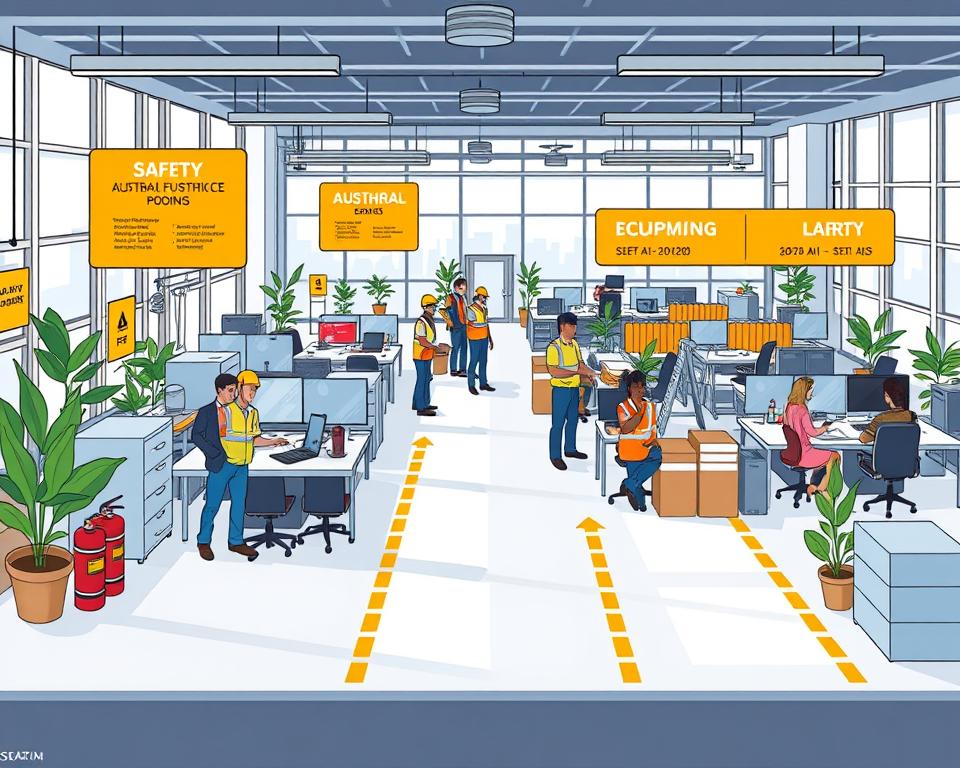Across Australia, we are recognising that a safe workplace layout and flow is not just a regulation but a vital pillar of productivity and employee well-being. In our pursuit of safeguarding our workers, we’ve come to appreciate that risk is not merely a concept to be wary of – it’s an operational factor that must be navigated with precision and vigilance. Safe Work Australia is at the helm, steering policies that ensure safety and compensation across diverse workplaces while state and territory governments enforce WHS laws tailored to the unique risks in their jurisdictions.
But what does this look like on the ground? For employers, this means that creating emergency plans and conducting first aid assessments are as crucial as morning coffees. Extreme weather or festive work parties are no longer just logistical concerns; they are arenas where the employer’s duty to ensure safety extends, irrespective of whether the clock is being watched. Even the rising tide of remote work doesn’t escape WHS obligations, as policies must adapt to protect the staff outside the traditional office landscape.
We understand that the backbone of compliance and safety isn’t just about ticking boxes. It’s a partnership where employers and employees alike are responsible for maintaining hazard prevention measures – from keeping machinery in check to following protocols meticulously. It requires an ongoing commitment to ergonomic design, providing not just the tools for the job but the safest ways to use them. It’s why businesses are advised to involve everyone in health and safety discussions, ensuring a transparent and holistic approach to workplace wellness.
Regular monitoring, risk assessments, and revisiting of control measures are pillars that support more than the physical structure of a business – they prop up the company’s integrity, resilience, and ability to propel its people to excel safely. And with the spectre of prosecution, fines, and retention issues looming over those that don’t adhere, the question isn’t whether we can afford to implement WHS practices – it’s whether we can afford not to.
In the following sections, we delve deeper into ergonomic design, workflow efficiency, and strategic hazard prevention, offering guidance that aligns with Safe Work Australia’s guidelines and the collective Australian ethos of promoting health in tandem with productivity.
Embracing a Safe Workplace Through Ergonomic Design
As we explore the pivotal role of ergonomic design in cultivating a safe workplace layout and flow, it’s clear that integrating well-thought-out ergonomics is key to enhancing efficiency and employee well-being across various sectors in Australia. By adopting ergonomic principles, workplaces can significantly reduce injury risks and boost productivity.

Understanding Ergonomics in the Australian Work Context
In Australia, ergonomic design isn’t just a buzzword; it’s a crucial factor in shaping work environments that prioritize safety and health. Statistics reveal that ergonomic interventions in manufacturing settings can slash injury risks by up to 40%. This substantial figure highlights the effectiveness of ergonomic practices in minimizing health hazards and cultivating a culture of safety.
Implementing Ergonomic Principles for Workplace Safety
- Adjustable Furniture: Ensuring that workspaces have furniture like chairs and desks that are adjustable not only supports proper posture but adapts to the diverse physical needs of individuals, ultimately enhancing comfort and productivity.
- Optimal Screen Placement: Screen-related strain is a common issue, which is why placing screens at an optimal distance of 18-30 inches from the user and at eye level can prevent neck and eye strain, fostering a healthier work environment.
- Sit-Stand Desks: Implementing sit-stand desks can reduce absenteeism by 20%, offering employees the flexibility to alternate between sitting and standing, thus promoting better circulation and muscle engagement.
- Ergonomic Tools and Equipment: Utilizing ergonomic tools like keyboard trays, monitor mounts, and adjustable lighting solutions can decrease musculoskeletal disorders by 25%, proving that proper equipment is essential for maintaining physical health in professional settings.
- Acoustic Management: Addressing acoustic challenges by using ceiling tiles and partitions helps minimize distractions and noise, which enhances focus and contributes to a more productive work atmosphere.
By incorporating these ergonomic strategies, businesses can achieve a safe workplace layout and flow, bolstering overall efficiency and employee well-being. These improvements not only enhance the immediate work environment but also contribute significantly to the long-term health and satisfaction of employees.
The Role of Efficient Workflow in Risk Mitigation
Ensuring a safe workplace layout and flow is pivotal in cultivating an environment where safety and efficiency intersect. As we delve into the intricacies of risk mitigation, the quintessence of an efficient workflow becomes undeniably evident. This is not just about enhancing productivity but fundamentally about safeguarding the lives and well-being of workers.
Adopting systems thinking is integral to managing and understanding the complex interactions within workplace processes. It aids in safe workplace layout and flow by ensuring each component of the work environment is cohesively aligned with safety protocols, thereby enhancing safety compliance.
Through strategic planning, we meticulously prioritize and define tasks, making risk mitigation more manageable and less prone to errors. Work systems are continuously reviewed and refined, highlighting risks and addressing them proactively rather than reactively.
- Visibility of risks made possible by digital management systems ensures all stakeholders are aware of ongoing or potential issues, promoting a proactive approach to risk management.
- Regular updates and continuous monitoring via digital tools offer immediate insights into risk changes, crucial for maintaining safety compliance and ensuring ongoing business continuity.
- Efficient workflow fosters quick responsiveness and adaptability to emerging threats, which is essential in dynamic work environments.
Moreover, training in risk management and assessment is indispensable. Ensuring every team member is versed in identifying and addressing risks not only boosts safety compliance but reinforces an efficient workflow conducive to a safe workplace layout and flow.
To encapsulate, the synergy between efficient workflow and risk mitigation strategies is fundamental in fostering a secure and productive work environment. By continuously honing these processes, businesses can achieve not just regulatory adherence but a robust framework that supports sustainable safety and operational excellence.
Strategies for Hazard Prevention in the Australian Workplace
In our continued efforts to promote a secure and productive working environment, understanding and applying targeted strategies for hazard prevention is fundamental. The integration of thorough risk assessment processes, adherence to safety compliance frameworks, and innovative solutions for workspace optimization are cornerstone practices that underpin our approach.

Initially, we focus on identifying common workplace hazards that range from potential falls and electrical risks to ergonomic and chemical exposures. This identification serves as the preliminary step in our holistic risk assessment process designed to manage and mitigate workplace risks effectively.
Identifying Common Workplace Hazards
- Fall hazards due to unprotected edges or slippery surfaces
- Electrical hazards from exposed wires or faulty equipment
- Fire hazards caused by flammable materials or faulty wiring
- Chemical exposures from handling toxic or corrosive substances
- Ergonomic risks leading to musculoskeletal disorders
Following hazard identification, our risk assessment approach considers both the likelihood and consequences of these hazards. This systematic assessment informs our decision-making, guiding us in implementing control measures to diminish risks.
Assessing and Controlling Risks Systematically
We prioritise safety controls that range from eliminating hazards, applying engineering solutions to segregate risks, to enhancing safety protocols and training. Implementing these controls is a testament to our commitment to safety compliance and risk mitigation.
- Utilising ergonomic furniture and tools to prevent musculoskeletal injuries
- Installing adequate signage for emergency egress and fire safety protocols
- Introducing motion-activated devices to reduce cross-contamination
- Ensuring all electrical systems are inspected and maintained to prevent accidents
Moreover, fostering a culture of safety is critical. Through effective communication strategies and regular training sessions, we empower our team to take proactive measures in hazard prevention. Our practices are further aligned with objectives to optimize the workspace, ensuring every area is designed to reduce risks and enhance safety.
Continuous education on the latest safety techniques and tools like PHReD-T, strengthens our ability to maintain high safety standards, crucial for protecting our staff and ensuring compliance with national safety regulations.
Through these integrated strategies, we not only comply with rigorous safety standards but also create a work environment that promotes health, efficiency, and productivity, effectively minimizing hazards and optimizing our workplace for better outcomes.
Workspace Optimization for Enhanced Safety and Productivity
In our pursuit of creating an optimal working environment, we steadfastly focus on workspace optimization that goes hand in hand with bolstering safety and uplifting productivity. By integrating ergonomic designs, our aim aligns with that of Safe Work Australia to establish workspaces that not only protect but also enhance the well-being and performance of our staff. The principles of ergonomics serve as the cornerstone in reimagining the arrangement of desks, chairs, and equipment to conform to the natural movements and capabilities of our employees, effectively reducing the risk of injuries which are all too common in poorly designed workspaces.
Given the data that links suboptimal ergonomic conditions to a substantial increase in workplace injuries, it is vital that we address these root causes with precision and foresight. By applying the Pareto Principle, we acknowledge that prioritizing critical ergonomic standards can address the majority of potential workplace hazards. Accessibility is not just an afterthought for us—it’s an integral element of workspace design. Creating an inclusive environment where all our employees can seamlessly access the tools and materials they need is not only a commitment to our diverse workforce but also a strategic objective that supports productivity enhancement. When employees are engaged in the workspace design process, from safety committees to safety audits, their active involvement fosters a culture of shared responsibility for safety and efficiency.
As we implement strategies for assessing risks—from physical to cyber—we establish a protocol to first identify hazards, then evaluate risks, and follow through with precise control measures, always ensuring that our surveillance and emergency responses are both reactive and proactive. Regular layout reviews are part of our sustainable commitment to an evolving and improving workspace. With these thoughtful measures, we don’t just comply with the national WHS standards, we aim to set a benchmark for them. Our goal is to foster a thriving workplace where safety is intrinsic, and every employee’s contribution towards the workspace design elevates the entire operational flow.
Workspace Optimization for Enhanced Safety and Productivity
Q: How can we ensure a safe workplace layout and flow in Australia?
A: Ensuring a safe workplace layout and flow can be achieved through the collaborative effort of consulting with workers, identifying hazards, conducting risk assessments, and implementing effective control measures. This includes ensuring the physical work environment, equipment, and task execution are all aligned with national WHS standards for a safe, ergonomic design that promotes productivity and reduces the risk of injury.
Q: What are the A key principles of ergonomic design to consider for workplace safety?
A: Ergonomic design principles include the consideration of physical, organisational, environmental, and psychosocial factors that can impact worker well-being and safety. The integration of ergonomic principles in the workplace encompasses optimizing physical layout, managing psychosocial risks, and ensuring that all elements of the work system interact harmoniously to support employees’ health and productivity.
Q: What does understanding ergonomics in the Australian work context involve?
A: Understanding ergonomics in the Australian work context involves a comprehensive grasp of how tasks, equipment, the environment, and human factors interrelate. Prioritizing ergonomic design in our workplaces ensures that we fulfil our commitment to providing a safe and efficient working environment, aligning with variety of ergonomic workplace standards and practices while also addressing psychosocial risks and maintaining employee well-being.
Q: How can we implement ergonomic principles to enhance workplace safety?
A: We can implement ergonomic principles by first conducting ergonomics assessments to identify potential hazards and then redesigning workspaces and tasks to align with ergonomic standards. This may involve adjusting the physical layout of workstations, providing ergonomic tools and equipment, offering training on proper work techniques, and considering the psychological aspects of work to reduce stress and strain on employees.
Q: Why is efficient workflow important for risk mitigation and safety compliance?
A: An efficient workflow is crucial for risk mitigation and safety compliance as it directly impacts the way tasks are performed and how workers engage with their work environment. By systematically identifying potential risks and implementing strategies to address them, businesses can maintain workflows that both comply with safety standards and keep productivity high. This involves clear communication, task prioritization, and regular reviews of work systems.
Q: What strategies can be employed for hazard prevention in Australian workplaces?
A: To prevent hazards in the Australian workplace, we must start by systematically identifying possible risks, assess their likelihood and consequences, and employ measures to control or eliminate them. This includes substituting dangerous items with safer alternatives, using physical barriers, applying engineering controls, initiating administrative controls, providing adequate training, and keeping comprehensive records for compliance and continuous improvement.
Q: How does workspace optimization contribute to enhanced safety and productivity?
A: Workspace optimization involves creating a layout that promotes efficient movement, access, and operation within a workspace. An optimized space not only enhances safety by reducing the risk of accidents and injuries but also boosts productivity by streamlining processes and making necessary tools and materials more accessible. This process must take into account ergonomic design, accessibility for all employees, and should be in compliance with Safe Work Australia’s guidelines for a safe and inclusive workplace.
Q: What role does accessibility play in workspace optimization?
A: Accessibility is a crucial component of workspace optimization as it ensures that all staff members can perform their duties effectively and safely, regardless of ability. Designing workspaces that are accessible to everyone helps to create an inclusive environment that supports worker well-being, enhances overall productivity, and complies with legal requirements pertaining to workplace health and safety.

